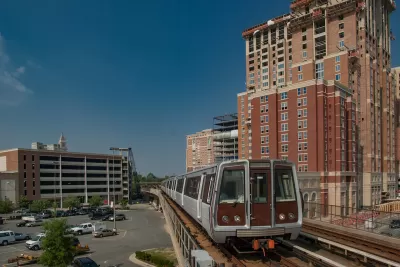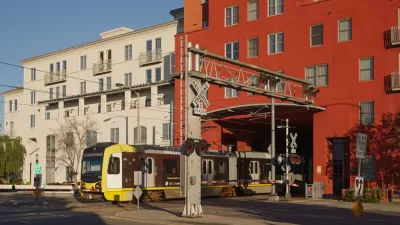Tying housing and land acquisition funding to transit projects could make dense, walkable development easier and more cost-effective.

Federal funding for transit-oriented development (TOD) is often siloed into its separate transportation and housing elements, making it more difficult to build developments that ostensibly combine transportation and housing to create more walkable and affordable communities.
As Kalena Thomhave explains in Smart Cities Dive, this is a problem because transit agencies often don’t own enough land to make development near stations possible. An analysis from the Urban Institute found that “housing is much more likely to be built far from transit, where land and housing costs are lower. Between 2000 and 2019, more than eight times as many housing units were built far from transit than nearby, according to the analysis.”
Cities can promote the integration of housing and transportation by creating a “dedicated land acquisition program” that would be tasked with identifying land acquisition opportunities near transit stations and tie funding for housing programs to transportation projects. In Seattle, Sound Transit has completed several TOD projects that pair new housing with light rail lines.
FULL STORY: How to ease the path to transit-oriented housing development

Planetizen Federal Action Tracker
A weekly monitor of how Trump’s orders and actions are impacting planners and planning in America.

Map: Where Senate Republicans Want to Sell Your Public Lands
For public land advocates, the Senate Republicans’ proposal to sell millions of acres of public land in the West is “the biggest fight of their careers.”

Restaurant Patios Were a Pandemic Win — Why Were They so Hard to Keep?
Social distancing requirements and changes in travel patterns prompted cities to pilot new uses for street and sidewalk space. Then it got complicated.

Platform Pilsner: Vancouver Transit Agency Releases... a Beer?
TransLink will receive a portion of every sale of the four-pack.

Toronto Weighs Cheaper Transit, Parking Hikes for Major Events
Special event rates would take effect during large festivals, sports games and concerts to ‘discourage driving, manage congestion and free up space for transit.”

Berlin to Consider Car-Free Zone Larger Than Manhattan
The area bound by the 22-mile Ringbahn would still allow 12 uses of a private automobile per year per person, and several other exemptions.
Urban Design for Planners 1: Software Tools
This six-course series explores essential urban design concepts using open source software and equips planners with the tools they need to participate fully in the urban design process.
Planning for Universal Design
Learn the tools for implementing Universal Design in planning regulations.
Heyer Gruel & Associates PA
JM Goldson LLC
Custer County Colorado
City of Camden Redevelopment Agency
City of Astoria
Transportation Research & Education Center (TREC) at Portland State University
Camden Redevelopment Agency
City of Claremont
Municipality of Princeton (NJ)





























